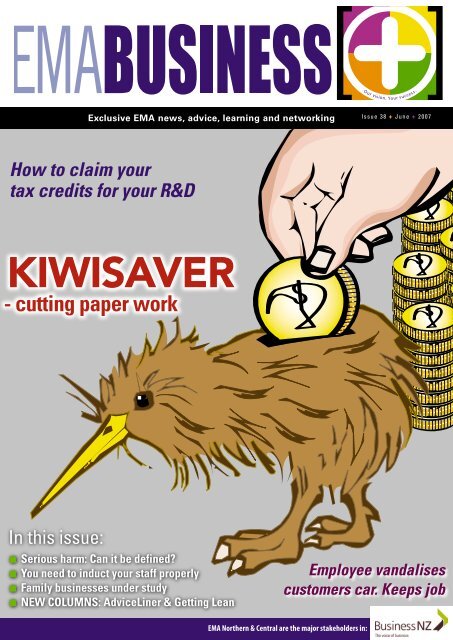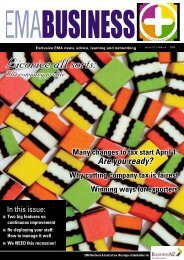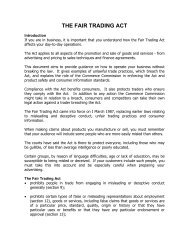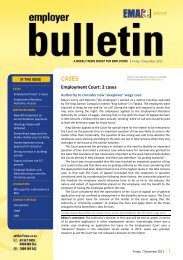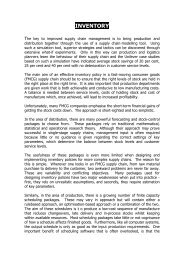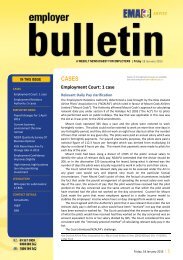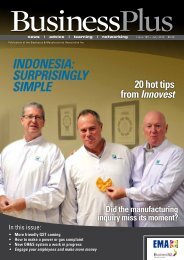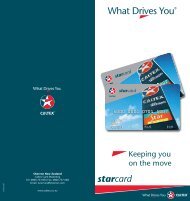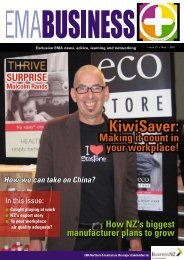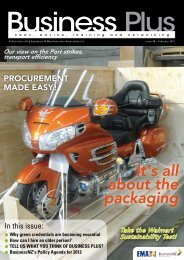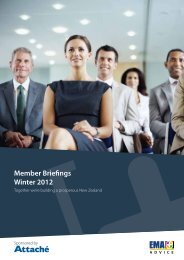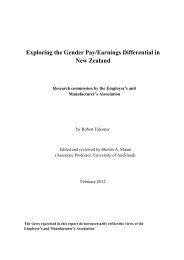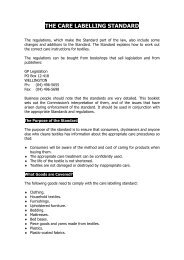KIWISAVER - EMA
KIWISAVER - EMA
KIWISAVER - EMA
Create successful ePaper yourself
Turn your PDF publications into a flip-book with our unique Google optimized e-Paper software.
Exclusive <strong>EMA</strong> news, advice, learning and networkingIssue 38 + June + 2007How to claim yourtax credits for your R&D<strong>KIWISAVER</strong>- cutting paper workIn this issue:■ Serious harm: Can it be defined?■ You need to induct your staff properly■ Family businesses under study■ NEW COLUMNS: AdviceLiner & Getting LeanEmployee vandalisescustomers car. Keeps job<strong>EMA</strong> Northern & Central are the major stakeholders in:
is published for:<strong>EMA</strong> Northern159 Khyber Pass Rd, Grafton,Private Bag 92066 AucklandPh: 09 367 0900 or 0800 800 362Email: ema@ema.co.nz Website: www.ema.co.nzChief ExecutiveAlasdair ThompsonAdvocacy ManagerBruce GoldsworthyManager, Employment AdviceDavid LoweManager <strong>EMA</strong> LearningGeorge GerardWaikatoAlan Fursdon07 839 0806Bay of PlentyKim Stretton07 577 9665<strong>EMA</strong> centralPO Box 1087 Wellington Ph: 04 473 7224Fax: 04 473 4501Email: ema@emacentral.org.nzWebsite: www.emacentral.org.nzChief ExecutivePaul WinterGisborne office06 863 2438Hawke’s Bay06 843 3419Taranaki06 759 4006Manawatu/Wanganui06 350 1825Nelson03 548 4528EditorGilbert Peterson 09 367 0916Published byTPL Publishing ServicesProject ManagerSheila Marshall 09 529 3007Advertising SalesColin Gestro 09 489 8911colin@affinityads.comISSN No. 1176-4953KiwiSaver - bolt from the blueThe Budget's last minute changes to KiwiSaver annoyed many employers.Suddenly they found they had to make compulsory contributionsand get their paper work sorted in short order. For manya whole lot of rework was needed. And just when thenew savings scheme was looking promising.In this issue of <strong>EMA</strong> Business + we short circuit someof the added work for you. On pages 13 - 17 you will findnew information to help.0203030406072508111214161918202326FINANCE The Budget, paradigms and common senseEnterprise education backed from the topAnand Satyanand, Governor General of New Zealand applaudsNETWORKING enterprise in schoolsTECHNOLOGY EntrepreneurshipAlasdair Thompson on why its important.MANUFACTURINGBudget benefits for exportersSerious harm is to be re-defined and it willaffect you!FINANCEA grounds keeper spraypainted a student'scar and kept his job; how good is that?Family NETWORKING businesses come under scrutinyTECHNOLOGYThe AdviceLiner: New Column!MANUFACTURINGWhat <strong>EMA</strong>'s Adviceline were being askedthis FINANCE monthInduct your staff: Programmes essentialNETWORKINGEmployment law roundup with Jasmine BrownTECHNOLOGYIRD flow charts KiwiSaver rulesMANUFACTURINGKiwiSaver bolt from the blue-The Business NZ commentaryTax credits for R&D: how to claim them- <strong>EMA</strong>'s E&Y Tax TipsFINANCEShoplifting...you NETWORKING are asking for it.- More telling tales from our private investigatorTECHNOLOGYWhat’s on the mind of IT decision makers?MANUFACTURINGDealing with employee mistakes - Get a gripGetting Lean to increasing productivity0403The AdviceLinerWhat employers are asking AdviceLine this month27<strong>EMA</strong>’s Export Year18Our Vision. Your SuccessPAGE
Budget benefits for exportersAmongst the $3.4 billion of businessbenefits in the Budget designed to liftproductivity and competitiveness were thefollowing – all to be invested over fouryears:n $2.1 billion for a company tax ratecut to 30 per cent, effective fromApril 1, 2008 – the amount it willreally cost Government is likelyto be far less since company taxis a withholding tax and subjectto franking credits, and the addedinvestment will stimulate investmentand tax payable in future years;n $112.5 million for new internationaltax rules to help companies expandoffshore;n $630 million for a tax credit forR&D – see page 17;n a tax exemption for active incomeof NZ controlled companies basedin overseas markets– this brings NZinto line with Australia, and wasoverdue;n an additional $87.8 million for theMarket Development componentof Enterprise Development Grants– the grants pool was way oversubscribed;n extra funding of $53 million toboost participation in industrytraining – there’s never enough fortraining;n an extra $6.3 million to extendNZTE’s Beachheads programmeinto China and India, place advisoryboards in all Beachhead regionallocations, and expand the KiwiExpatriates Abroad (KEA) network;n an extra $19.4 million to increaseNZTE in-market assistance forNZ firms in China, India and Japan– why just those destinations?n $1.6 million toward NZ’s participationat the next World Expo inShanghai in 2010;n $50 million for a new contractbonding product for NZ exportersbidding for US Federal or Statecontracts where they are required toprovide a bond (or cash) equal to atleast 100% of the transaction.Path to MarketThe Path to Market programmesupports export-ready companies to fasttrack their entry to specific markets. Itstargeted at companies new to exportingor those building their capability toassess specific markets. A group ofeight ICT companies and seven fromthe specialised manufacturing sectorhad their sales pitches critiqued by apanel of experts in April. Six of theICT companies then visited CeBIT<strong>EMA</strong>’s Export YearAustralia in Sydney from May 1-3,accompanied by Export Year championKen Stevens. The participants forSpecialised Manufacturing were due toattend National Manufacturing week inAustralia at the end of May.The end?Export Year 2007 climaxes with theannual Export Awards in November.The official line is that Export Year2007 aims to increase New Zealand’ssustainable export base by makingour firms “stronger, more resilientand more capable and will strengthenthe foundations for long term exportgrowth – ensuring New Zealandcontinues to compete and thrive inglobal markets. As businesses flourish,communities flourish too – and thatmeans improved standards of living forNew Zealanders."That’s a lot of fine sounding wordsand they’re only as good as how theytranslate into real advances in businessperformance and growth.New Zealand has about 340,000small to medium enterprises; 12,900of them export, with a handful (about170) earning 75 per cent of all foreignearnings. An improvement in NewZealand’s exporting performance overthe long term will take more than aone-year initiative….Export Year eventsMuch Export Year thus far has been topromote the events and other activities thatwould have taken place if 2007 were notExport Year. Much is business as usual. Butthe extra work going into promoting themshould not be denigrated.Activities include:n Export Breakfasts organised by ExportNew Zealand - 1150 exporters havereceived informal training, learned fromeach other and networked;n A focus on exporting at conferencesand seminars run by the EconomicDevelopment Association of NZ (EDANZ),Meat & Wool NZ, Marine IndustryAssociation, NZ Pacific Business Counciland the NZ Japan Business Council,‘New Thinking Week’ and the Better ByDesign ‘CEO Summit’.n Channeling training courses, onlineassessments, exporter news, marketinformation and other resources andtools through: www.exportyear.co.nz.n Seminars due on exporting to UK andJapan.n ‘Argentina’ is to be held in Hamiltonby the Embassy of Argentina in NewZealand, NZTE and the Latin AmericaNew Zealand Business Council.n The International Cities and Town CentresConference is being held in Auckland onJune 26-28.Other particularly welcome initiatives are:1. Launch of Thinking Globally teachingresources for social sciences teachers touse in primary and secondary schools;2. Launch of a pilot of the internationallyaccredited Certificate and Diploma inInternational Trade;3. Revision and expansion of the content inthe Exporter Education Programme.PAGE <strong>EMA</strong> Business Plus Magazine - Exclusive <strong>EMA</strong> news, advice, learning and networking
Stack the riskand return in yourfavour…Building a business and setting up the rightassets that will provide for your financial securitydemands hard work, sacrifice and carefulplanning.Very often we’re working so hard and making thesacrifices that we slip up on the planning, or put itoff until later…sometimes until it’s too late.Having the right plans in place at the right timecould make all the difference. Have you everwondered how someone’s business can go belly upand yet their lifestyle hardly misses a beat?They continue to live in the comfortable familyhome, enjoy weekends at the bach and by allaccounts, life is as it was before.The answer is simple:Have proper plans in place, in time,and keep them up to date.Guardian Trust is New Zealand’s specialist trusteeand financial adviser. Our qualified team oflawyers, accountants and financial advisers canhelp you set up co-ordinated legal arrangementsthat will provide for anticipated or unforeseenevents, making sure your hard earned assets areprotected and you and your dependents continueto enjoy their benefits:• WillsHave you reviewed your will in the last threeyears to ensure it still meets your wishes?• Enduring Powers of AttorneyHave you appointed someone to manage youraffairs if you became incapacitated and wereunable to do so?• TrustsCould a trust give you better planning powerand protection?• Retirement and Investment PlanningWill your investments fund the lifestyle youenvisage in your retirement?• Buy/Sell AgreementsHave you planned ahead for a smooth transitionto avoid potential conflict and stress?Guardian Trust is the <strong>EMA</strong>’s preferredpartner in asset protection andmanagement.For a complimentary consultationto discuss your options or review yourexisting plans, contactBryan Ivamy on (09) 529 1659Our Vision. Your SuccessPAGE
By David Lowe, <strong>EMA</strong> Northern’s Manager ofEmployment Relations ServicesFiring requires more than spraypainting students carThe groundskeeper for Cambridge HighSchool, Mr Bell, spray-painted thewindscreen of a student’s car becauseit was blocking a gate leading to thesports field. Mr Bell wanted to driveon to the sports field to pick up somefirewood for his friend, and had to useanother gate to get to the firewood.Mr Bell explained his actions on thebasis that the particular gate was anemergency exit. He also said thatspray painting the car was, in part,inspired by frustration at the vandalismoccurring around the school.The High School went througha disciplinary process which theEmployment Relations Authorityagreed was in accordance with theemployment agreement. But Mr Bell’sdismissal was held to be unjustifiedbecause he was not told his job wouldbe on the line. Mr Bell said if he hadknown that, he would have brought arepresentative along to the disciplinarymeetings. He thought he would get aslap on the wrist.Apparently it is not simplecommonsense that spray painting astudent’s car might put your job on theline. But as we know from this andother cases employers cannot rely oncommon sense.The Employment RelationsAuthority cannot really be blamedfor their decision. Maybe it was a bitpedantic, but that is the law as it stands.The Authority did what it could toremedy the inherent unfairness createdwhen it was left with little choicebut to find the dismissal unjustifiedbecause of the procedural flaw. MrBell was not awarded any lost wages orcompensation.However, the Authority washamstrung in relation to costs.Following a finding of unjustifieddismissal, the high school had tocontribute to Mr Bell’s legal costs aswell as pay its own.The law makers seem to haveforgotten that the majority ofbusinesses are small; four or fivepeople quietly working away innon-descript buildings. But thesesmall businesses are expected to havesome mythical team of employmentlawyers on hand to guide themthrough the maze called ‘proceduralfairness’.The current law is under review.We hope the law makers will realisemost employers are small and donot have the army of employmentexperts that the current law assumes.(See further comment on page 10)EARTHAIRFIREWe generate power from more sources than anyone else.WATER0800 600 900genesisenergy.co.nzGED8343GED8343 <strong>EMA</strong> Business Mag 128x1851 112/1/06 9:48:22 AMOur Vision. Your SuccessPAGE
The AdviceLinerWhat employers are asking AdviceLine this month<strong>EMA</strong> Northern’s AdviceLine handles awide variety of employment related callsevery week. This column each issue of<strong>EMA</strong> Business+ will record the latesthot topics and what you need to knowabout the issues underlying them.The management of annual leaveis highly topical at present with theincrease of minimum entitlement tofour weeks from April 2007.While the Holidays Act saysemployers must not unreasonablywithhold consent to an employee’srequest for annual leave, employers oftenhave difficulty getting some employeesto use up their leave entitlement.The rules around the taking ofannual leave• An employer must allow an employeeto take annual leave within 12months after the date on which theemployee became entitled to theleave.• Employees can elect to take 2weeks of their leave entitlement in acontinuous period.• When leave is to be taken should beagreed by the employer and employee.• An employer must not unreasonablywithhold consent to an employee’srequest to take annual leave.agreement on when they are going totake the leave.Can employers require employee totake leave in advance?If an employee does not have a leaveentitlement, for example if they havebeen employed for less than a year, theparties can agree that an employee cantake leave in advance of entitlement. Anemployer can not require an employeeto take leave in advance.Can employers require employeesto take all or some of theirannual leave during a customaryclosedown period?It is common for employers toclosedown all or part of their operationsover the Christmas and New Yearperiod and special rules apply to ensureyou can require employees to take leaveduring a customary closedown.Employers must still follow thenotice requirements of the HolidaysAct and we recommend employersmanage employee leave applicationsduring the year to ensure employeeshave enough leave entitlement availableto cover a closedown period. If anemployee without leave entitlement isrequired to discontinue their work overthe closedown period their anniversarydate for annual leave purposes mustbe changed to the date on which theclosedown began.The Holidays Act contains aprovision for managing the closedowndate in order to avoid having adifferent date in each year on which anemployee becomes entitled to annualleave. Alternatively you can agree thatemployees will take some leave inadvance.Do employees lose untaken annualleave?No. Employee’s annual leave remainsuntil it is taken as paid leave. Untakenleave is paid out on termination ofemployment.This information is an overview of someissues to consider. Individual scenarios willoften raise particular issues. <strong>EMA</strong>’s EmployerGuide on leave entitlements covers all theabove in more detail and can be accessedat www.ema.co.nzIf you need help callAdviceLine on 3670909 or 0800 800 362. Orcall <strong>EMA</strong> Central on 04 473 7224Can an employer direct anemployee to take annual leaveentitlement?The short answer is yes. Howeverthe taking of annual leave should beby agreement, but if agreement cannotbe reached an employer can requirean employee to take annual leaveentitlement by giving not less than 14days notice. If you have an employeewho has a large amount of untakenleave you should raise the issue withthem with a view to reaching an<strong>EMA</strong> Northern's Manager of Employment Relations, David Lowe, in full flight. Headdressed some 2000 <strong>EMA</strong> member representatives at KiwiSaver seminars in June.PAGE <strong>EMA</strong> Business Plus Magazine - Exclusive <strong>EMA</strong> news, advice, learning and networking
What drives thecommitment and productivity ofyour employees?1920 HOURS A YEARThe 8th annual unlimited/JRA Best Places to Work in New Zealand Surveyis an opportunity for you to gather employee feedback to address thesecritical questions.Over 250 organisations employing over 40,000 people will take part in2007. You can run the survey in your organisation anytime between Julyand September.For more information or to register, visit www.jra.co.nz/bestplacestowork/ema
Get yourbusinessconnectedwith Orb!GET MOBILESamsung W531A great business phone withan <strong>EMA</strong> call plan to suit howyou work or play.• Bluetooth ® capable• 1.3 Megapixel camera$49+GSTon 24 month <strong>EMA</strong>Association 100 planGET SMARTAvaya IP Office Phone SystemThe latest IP technology to reduce costsand connect to customers and staff.Telecom BusinessTimeCapped calling rates andlow access fees tostreamline your office.TERMS & CONDITIONS: Telecom terms, conditions and charges apply.MONTHLY PLANS: Credit criteria and monthly access fees apply.DISCONNECTION FEES: If you are an existing Telecom Mobile customer incontract and you wish to take up any of these offers, you may be subject todisconnection fees under your existing contract. <strong>EMA</strong> Association 100 Planis available to members of the <strong>EMA</strong> association only, until further notice.EXPIRY: All offers are valid until 30 June 07 or while stocks last.STORESNATIONWIDEMOBILEPHONESYSTEMSINTERNETOFFICEEQUIPMENT0800 346 775 ORB.CO.NZ
By Helen ApplebyInduction programmes essentialWith approximately 600 people aweek migrating from New Zealandshores, labour shortages are aserious problem for business as thecompetition for staff hots up anddelivery or service commitments arecompromised.With an increased dairy payoutrecently announced from Fonterra,the Waikato economyis more affected by thisphenomenon perhaps thanother regions; Waikato isguaranteed to keep growingfor the foreseeable future.But where will we get allthe extra labour to supportgrowing businesses andprovide services when thecountry has such a lowunemployment rate?As a migrant to NewZealand I saw the potentialin the Waikato and could seeAuckland had growing pains, andthat the Waikato could benefit fromAuckland’s troubles.But in responding to the needfor more employees, does Waikatopromote itself well to potentialmigrants, and how easy is it anywherefor new migrants to engage withemployers and colleagues?The Waikato has a largeproportion of family run SME’swhich may not have the budget, timeor expertise to seek staff directlyfrom overseas. Human resourceplanning for them can be adhoc andreactive.Though the Immigration Serviceassists recruitment by providingenterprises with an accreditation thatspeeds up the immigration process, alarge proportion of small businessesare unlikely to seek this.An alternative is to grow anddevelop our own local talent, selectthe right people, and spend the timeand money engaging comprehensivelywith them.Recently a client told me two ofhis employees in different areas of the"...the costs associatedwith a staff replacementcan be as high as 50-70 per cent of the newappointment’s firstyear salary..."company left after just three months.PricewaterhouseCoopers estimatesthe cost of replacing an employee canbe calculated by adding the directand indirect costs associated withthat replacement – the figure can beas high as 50-70 per cent of the newappointment’s first year salary.Replacing staff is costly and onesurely to be avoided. How? Byundertaking a thorough recruitmentand selection process followedby a well planned and executedinduction programme, with arelevant performance developmentplan tailored to the needs of theindividual and your organisation.When many employers havelittle time to devote to this work,where do you start? My answer isemployers cannot afford to ignoremaking this effort. They may liketo take training on ‘InductionEssentials’.Employers and managers wholeave new staff to sink or swim arestoring up trouble for themselves.Many people go to workexpecting to feel valued, and theyenjoy being part of a team.Employees today canafford to consciouslychoose whether they wishto work for a particularperson or organisation.But if their employer neverhas the time to explain, orrarely communicates plansand ideas, and seldominvolves them in the futureof the business, whathappens?Being an HR consultanthas let me see insidemany organisations and with a fewexceptions, induction programmesare not commonplace.But learning does not happen byosmosis. And learning along withskill development are keys to growthfor both people and businesses.New migrants especially need aninduction that encompasses howthings are done in New Zealand,plus the time and opportunity tore-establish their roots. Who betterthan their new work colleagues tohelp this happen?Helen Appleby is Senior HR Consultant forPricewaterhouseCoopers in Hamilton,Ph 09 838 7410Our Vision. Your SuccessPAGE 11
Employment law roundupEmployment law is always evolvingand developing and here are some recentexamples.Last year in “the graffiti” case, (Paterson vWoodland Developments Ltd -AA178/06),an apprentice employee sprayed aswastika on a Jewish client’s house.Last month in Bell v Cambridge HighSchool (AA70/07) a school caretakerwas dismissed after spray-painting thewindshield of a student’s car. (see Newson p7). In both cases the Authority heldthe dismissal was unjustified because theemployer did not follow an appropriatedisciplinary procedure.While the actions of an employeemay be appalling, it is essential foremployers to follow precise procedureswhatever the circumstances.Holiday cases on the moveJust when we thought three keyholiday cases were settled, each is goingto appeal. Business New Zealand willapply to intervene in both appeals.<strong>EMA</strong> are their representatives.The Air New Zealand v NZ AirlinePilot’s Union [2007] NZSC 12 caseconcerns “exchange days” under s44 ofthe Holidays Act 2003. The Court ofAppeal’s finding was that parties to anemployment agreement could exchangea public holiday but this “exchange day”had to be another specified day.The pilot’s collective employmentagreement ties in an additional 11 daysto its annual leave provision to recognisepublic holidays because it has to operatea 24 hours a day all year. Air NewZealand contends such an agreementis legal and the “exchange day” doesnot need to be identified. The unioncontends the 2003 Act does not providefor “exchange days” so the clause is notlegal. Both points will be at issue onappeal.The NZ Professional FirefightersUnion v NZ Fire Service Commissioncase concerns alternative holidays, andwhether these need to be specifieddays under s57 of the Act. For practicalpurposes, additional days’ leave aretied into the roster in advance torecognise any alternative holiday thatmight become due. The Court ofAppeal decided these days do not needto be specified so long as they occuron an “otherwise working day”. TheCourt determined that the “otherwiseworking day” meant any day anemployee would be required to workif not taking that day as holiday. Theunion wants to appeal both points.New Zealand Tramways and PublicTransport Union Inc v TransportationAuckland Corporation Ltd (“Stagecoach”case) is about the four week’s annualleave entitlement, which commencedApril, 1 2007, and whether employeesalready contractually entitled to fourweeks gain an additional week’s leave.The Employment Court decisionturned very much on the particularclause in the collective employmentagreement that provided an additionalweek’s leave but capped it at fourWith Jasmine Brown, KnowledgeManagement Lawyer with <strong>EMA</strong> Centralweeks. The union wants to appeal thisdecision on two grounds. First, theadditional week in this particular clauseis not intended to be annual leavebut a holiday in recognition of someadverse work conditions. Second, thatthe new provisions intend to provideall employees with an additionalweek’s leave whatever their pre-Aprilcontractual entitlement.Combating speculative claimsAllan v Longlas Ltd (WA47/07) is agood illustration of what employers cando when faced with a highly speculativeclaim. It shows employers can win costs.A former employee of Longlas fileda claim for unjustified dismissal. Hisclaim lacked specificity and supportingevidence. The employer’s representativesasked several times for particulars, andwhen deadlines had passed, applied tostrike out the application.Strike out applications can andshould be made by employers when anemployee’s claim lacks merit, when theapplicant does not provide sufficientspecificity in their claim, and will notamend it.Faced with this and a strongindication from the Authority thatfurther particulars of the claim werenecessary, the employee withdrew hisclaim. But then the employer claimedtheir significant time and money onthe case against the employee. Costs of$3000 were awarded to the employer.Blair Scotland of <strong>EMA</strong> Legal acted forthe employer in this case.Specialist Employment Lawyersemployers. As part of a member-owned organisation, <strong>EMA</strong> Legal offers services that are excellent value.Strategic advice Practical solutions Skilled representationKey contactsSusan-Jane Davies (04) 470 9923 sjdavies@emalegal.org.nzParvez Akbar (09) 367 0931 parvez.akbar@ema.co.nzElizabeth Brown (06) 843 3419 elizabethb@emalegal.org.nzPAGE 12<strong>EMA</strong> Business Plus Magazine - Exclusive <strong>EMA</strong> news, advice, learning and networking
Looking for truly simple KiwiSaver ready payroll software?Ace PayrollAce Payroll is New Zealand’s most widely usedpayroll. Ace Payroll, the company, has 20 yearsexperience focused entirely on payroll.“People choose us for three simple reasons,” saysPhil Eriksen of Ace Payroll. “Our software is veryeasy to use, our prices can’t be beaten and our0800 helpdesk actually answers the phone andknows the answers to your questions.”“It may sound silly,” he continues, “but in recentyears this has become a key feature. A lot ofpeople can create a payroll system but what it isreally about is continual enhancement and beingavailable every minute of every payday.”The last few months for Ace Payroll has been spentimplementing the KiwiSaver scheme. “KiwiSaver hasthe potential to be hard for employers and I wouldnot want to do it manually, but we have put greatemphasis on making the new routines simple,” saysEriksen.Ace Payroll logically handles the opting in and outrequirements of KiwiSaver, offers extensive reporting,makes the deductions automatically and creates themonthly returns in an IRD approved format eitherelectronically or to paper.In addition, a comprehensive F1 manual is includedon the CD. New documentation covers KiwiSavercomprehensively and even links to the legislation,allowing employers to gain a true understanding ofhow it works.“A lot of people profit from confused, scaredemployers,” says Eriksen. “That is why you see somany seminars and people offering to take yourwages off your hands!”Ace Payroll’s approach is to empower employers bymaking things simple, while making sure employersunderstand what is happening. “All of our screenshave clear help messages, often quoting thelegislation you’re complying with,” says Eriksen. “Thismeans, rather than just trusting a piece of softwareor a bureau service, you can keep an eye on this vitalpart of your business and actually understand it.”Ace Payroll contains many other features to makethings easy. It is fully IRD compliant and allows anIR-file to be sent electronically to IRD, or printed inthe correct format. There are over 40 different reports,direct credit routines for every bank and flexibilityabounds in every area.“For example,” says Eriksen, “you can print a reportfor an employee showing 15 years data on one report.I know of no other payroll that can do that.”One feature a lot of Ace Payroll clients love isemailing payslips. Like everything else, it is easy to doand can usually be set up by the payroll clerk, not anIT person. “I know of one client who is saving $2000a week by emailing payslips. This is by using a systemthat costs them a couple hundred a year. Needless tosay they are over the moon!”The focus on ease of use and stability allows AcePayroll to be very competitively priced. “We’rehappy to offer Ace Payroll to any <strong>EMA</strong> member for$250+GST,” says Eriksen.This price includes the Ace Payroll software, sixmonths 0800 support and a 90-day right of return ifnot totally satisfied.Ace Payroll can be contacted on 0800-223 729 andthe software can be purchased over the phone. Thereis an extensive website at www.acepay.co.nz, whichhas hundreds of questions and answers about AcePayroll, legislation relevant to employers and muchmore.“If you want to be blown away, check out ourtestimonials at www.acepay.co.nz/testmony.htm,”says Eriksen “Some of our clients are almost fanaticalabout the system, and I’d love for you to become oneof them.”Contact us today tofind out more:Ace Payroll0800 223 729www.acepay.co.nz
IRD flow charts KiwiSaver rulesGet moreKiwiSaverguidesThe KiwiSaver employerguide was recently sent toall employers.It’s a ‘how to’ onKiwiSaver focusing onyour obligations as anemployer. It is also providesinformation on your optionsand what the changes asoutlined in Budget 2007could mean for you.To help employersunderstand KiwiSaverjargon, the guide has a‘frequently asked questions’section and a glossary ofterms. Its has been designedso that the really importantinformation is summarisedin a ‘What’s important’ boxwith specific examples.You can download morecopies from the InlandRevenue website: www.ird.govt.nz/kiwisaver/ or call itsINFOexpress line on 0800 257777 to get a copy posted toyou.Driving business performance, and economyMake sure you are a fi nancial member of<strong>EMA</strong> on 30 June 2007 and you couldwin a fantastic Nissan Maxima Ti.PAGE 14<strong>EMA</strong> Business Plus Magazine - Exclusive <strong>EMA</strong> news, advice, learning and networking
...follow the arrowsKiwiSaver Employee WorkshopsYour employees’ need to know about KiwiSaver:• Do they have to join?• How does KiwiSaver work?• What should they do?A workshop run at your workplace will ensure your employees’get the information they need direct from the experts.You can rely on <strong>EMA</strong> to explain KiwiSaver in a way thatsupports your business.Run by experienced <strong>EMA</strong> consultants at membership rates.For more information call:0800 800 362Our Vision. Your SuccessPAGE 15
KiwiSaver – the bolt from the blueThere is a big gap between employersand employees on KiwiSaver. Foremployees, the scheme is very attractive– a thousand dollar sweetener on joiningand four per cent compulsory employermatching contributions.Employers will be less happy. On theone hand, it’s good news that we finallyhave a retirement savings regime.But the way it was delivered willleave a sour taste for many. On Budgetday the Government dropped abombshell on business – it’s going to becompulsory for employers to pay intotheir employees’ KiwiSaver accounts.No consultationThis literally came out of the blue.There had been no discussion orconsultation with employers whatsoever.No opportunity to discuss timingor potential tradeoffs; not even anydiscussion on whether there is in fact asavings problem that would require suchcompulsion.Given the extremely high levelof consultation that occurs betweenGovernment and Business NZ and<strong>EMA</strong> over a very large range ofbusiness issues, the silence over plans foremployer compulsion was remarkable.In fact the Government hadpreviously consulted very carefullythroughout 2005 and 2006 to gainwidespread support for KiwiSaver as avoluntary scheme, and employers hadagreed to help administer it on thatbasis.There would have been manyoptions for KiwiSaver’s eventual shape,so it is amazing that this reversal ofpolicy in the 2007 Budget – making itcompulsory for employers to contribute– was selected without any discussionwith the sector that would bear the cost.Unusual choiceThis option is, in fact, a most unusualchoice. In other countries withcompulsory retirement savings schemes,it is the saver (the employee) who is thesubject of compulsion. Since it is saverswho will benefit from the scheme, thecompulsion rightly falls on them.But remarkably, here in NewCasual workers off mandatory list for KiwiSaverHidden in the details of the Budget 2007 was something business has been hopingfor; the Government is changing the rules regarding casual employees in relation toKiwiSaver in a way that helps!From 1 April 2008, all employees entitled to be paid holiday pay on a ‘pay as you go’basis under the Holidays Act will be excluded from the automatic enrolment rules ofKiwiSaver.These employees can choose to join KiwiSaver, but they will not be automaticallyenrolled and have to actively opt out.Any employee employed on a fixed term basis for less than 28 continuous days will alsobe excluded. But any fixed term employment of 28 continuous days or more will besubject to automatic enrolment in KiwiSaver.The original KiwiSaver Act created an administration nightmare for businesses whowould have had to work out when a casual employee had completed 28 continuousdays of service.While this 28 continuous day rule for casual employees will be the law fromJuly 1, 2007to March, 2008 31, a much simpler arrangement will come in to effect on April 1 2008, ifthe changes proposed in the Budget become law.<strong>EMA</strong> lobbied hard to have this 28 day rule removed for causal employees, and thechange will be welcomed by business and casual employees alike.Zealand we now have a scheme whereit is voluntary for the saver to save,but compulsory for the employer tosubsidise it!Employers have not been backwardin complaining about the decision.At <strong>EMA</strong> briefings after Budget day,business disappointment has beenpalpable. “It’s an angry crowd outthere,” <strong>EMA</strong>’s David Lowe said,following briefings to about 500employers. The cost is one issue, but it’sactually the terrible timing.”From next April employers willhave to start matching their employees’contributions. But many employersare tied into three-year collectiveagreements, so the KiwiSaver impostwill have to be on top of that.Industrial tension?The Government has suggestedthat employer KiwiSaver contributionsshould become a wage-bargainingchip, making up a part of total salarynegotiated between employer andemployee. In fact, however, unions areviewing compulsory KiwiSaver contributionsas additional to pay increases,and are showing no inclination torenegotiate longer-term collectiveagreements to incorporate a KiwiSavercomponent.This suggests we may have someindustrial tension ahead. The voluntaryopt-in for employees will be hardto bargain around. Companies andunions will be bargaining on the basisthat some will opt in and others won’t,making bargaining very complex.In a situation where two employeesearn the same amount – for exampleJohn and Fred each earning $40,000 -and John opts in to KiwiSaver and Freddoesn’t, it creates a relativity problem forthe future.They have each negotiated a salarypackage - John’s $40,000 includesthe employer contribution and Fred’sdoesn’t. If, later on, Fred decides to optin to KiwiSaver, will the employer’scontribution be part of, or on top of,the $40,000 package?PAGE 16<strong>EMA</strong> Business Plus Magazine - Exclusive <strong>EMA</strong> news, advice, learning and networking
I can see employers and unionsgiving very different answers to thatquestion.Some employers might think ofgetting round the problem by putting aclause in Fred’s employment saying thatthe wages received will reduce by theamount of the employer contributionif he later opts in to KiwiSaver. Butthis would just be attacked in Court byunions as ‘rectrospectivity’ (agreeing inadvance of something happening thatcould be to the employee’s detriment)and illegal ‘contracting out’ of responsibilitiesunder the Act.It looks like the KiwiSaver legislationwill have to be tested in Court to getcertainty about what it means – anotherunnecessary, expensive outcome fromemployment law.Do we have a retirement savingproblem?And all this without researching tosee whether there really is a retirementsaving problem. It’s astounding thatthere is no in-depth research on NewZealand saving patterns. The Harrisreport, on which the KiwiSaver schemeis based, says there is a savings problem,but does not give adequate evidenceon which to base the claim. In fact, theHarris report underestimated the levelof retirement savings by not includingthe almost half million individuals whobelong to retail superannuation schemes.And a Treasury study* indicates thatin fact there might not be widespreadunder-saving for retirement.Employers must pay equivalent offour per cent of salaryThe scheme will see employers’compulsory contributions rising fromone per cent of employee wages tofour per cent from 2011 onwards. Thiswill be partially offset by a tax creditup to a maximum of $20 per week peremployee – useful in year one whenemployers will be paying at a rate ofone per cent of employee salary, buttotally inadequate once the requirementincreases to four per cent by 2011 andthereafter.This won’t hurt a bitThe Finance Minister has said thatthe net additional costs to employersby 2011-2012 should overall be nomore than one per cent of the nationalwage and salary bill at that point. Thisis based on the estimate that about50 per cent of employees are likely tojoin KiwiSaver. But that 50 per centis not only an estimate, but an average– and averages can be misleading. Forthe subset of employees that opt in toKiwiSaver, the increased cost for theiremployer will not be one per cent buttwo per cent (or three per cent or morefor the higher paid).ComplianceNor does this include the compliancecosts, which will be substantial. Giventhat around700,000 people start a new jobeach year; this represents an ongoingcompliance burden for employers.The opt-in and opt-out provisionswill make it more complex still. Theemployer will be required to be theconduit between the employee andthe IRD, passing on relevant formsand information, administering salarydeductions which can stop and startfor ‘contributions holidays’ and so on.Business NZ’s CEO Phil O’ReillyEmployers who get ‘exempt’ status willhave still more obligations. And themortgage diversion features will bringunnecessary triple-handling by theemployer, IRD and the chosen superscheme.Financial adviceEmployers are also implicated in thearea of financial advice – somethingthey will be well advised to steer clearof. The potential for employer liabilityexists if a scheme recommended by anemployer fails in any way. Supplyingan information pack, giving afactual description of KiwiSaver, andpromoting benefits of retirement savingsin general is the safest course of actionto avoid the risk of liability.<strong>EMA</strong> will continue with its highlyregarded seminars on administeringKiwiSaver and I recommend attendanceby any business wishing look after itsemployees’ and its own interests.Phil O’Reilly is Chief Executive,Business NZ*Scobie, Gibson & Le: Saving forRetirement: New Evidence for NZOur Vision. Your SuccessPAGE 17
the future just got brighter...www.horizonrecruitment.co.nzTrue stories from the security files of: Rod Moratti, Private InvestigatorShoplifting...you are asking for it.Many years ago as a child I witnessedshoplifting in action at a supermarketon Auckland’s North Shore. Evenat a young age I picked up the bodylanguage of some kids and watchedthem discretely as they placed itemsinside their clothing. Despite adultsbeing in the vicinity no-one seemedaware what was going on and when Iapproached the customer service deskto advise what I had witnessed noonewas prepared to act. The thievesdecamped unimpeded.Twenty five years on it is stillevident to me that shoplifting iscaused by slack shop and customermanagement; it can be remedied.Shoplifters generally come intwo forms; the opportunist who isdoing it for the thrill, and organisedshoplifters who more often thannot are foreigners working in teamsand only in the area for a short time.Both can be put off orapprehended by taking some costeffective and simple measures.The average shoplifter can bespotted a mile away, and interceptedbefore any losses occur. Ideally,your store will have closed circuitsurveillance with one camera coveringthe entrance to the store and a clearenough view to capture an identifyingimage of customers and would-berobbers.You will also have cameraswatching all ‘desirable’ products,especially small items. A monitorshould be placed in such a positionso customers can see themselves andare therefore aware they are beingwatched and recorded. But camerasalone will not deter theft.The opportunist shoplifter willnearly always loiter and be uncertainof their actions. They will take a longtime to decide what they are going tosteal and how they are going to do it.You should be able to pick up theirbody language and approach themin the usual manner. Don’t be putoff if they decline your help; engagethem in conversation or subtly letthem know you are not going toleave them alone with enough timeto steal. If you are right, they willmake their way out of the store andrethink their plan, either moving onto another store or canning the ideaaltogether.Of course bags are an issue.Security guards at large stores areoften fooled by hidden pockets andcompartments in bags where itemscan be concealed. But the idea is tostop them before items make theirway into the bag.Organised shoplifters often workin pairs or teams with one partydistracting the staff member andthe other committing the theft.This usually occurs with high valueproduct such as jewellery, sunglasses,electronic items or perfumes whichtherefore justifies the lock up ofcertain items in glass cases. Onlybring out one item at a time forshowing.I was recently at a store inNewmarket looking at i-podsand the staff member there got itprecisely right. He made a point oflocking up one i-pod before goingto the next cabinet. “Trust no one”.n Don’t make the mistake ofthinking some losses throughtheft are inevitable. If an offendersteals from you successfully theywill be back for more and maytell their friends. Before youknow it your losses are extreme.No theft is acceptable.n Dummy cameras only fooldummies. I can pick them from realcameras and so can criminals.n If you’re an <strong>EMA</strong> member, call oremail me, mention this article and Iwill provide you a free, no problemconsultation to assist with your storeor business security.Rod Moratti is the principal at Moratti &Associates, Licensed Investigators since1989. Contact Rod on 027-6958863 at anytime or email rod@moratti.co.nz or visitwww.moratti.co.nzPAGE 18<strong>EMA</strong> Business Plus Magazine - Exclusive <strong>EMA</strong> news, advice, learning and networking
<strong>EMA</strong>'sTAX TIPSTax credits for R&D: How to claim them By Colin De FreyneThe Budget heralded a new researchand development (R&D) tax creditregime for New Zealand businesses,the aim of which is to improveproductivity and internationalcompetitiveness.The regime will encourage businessto invest more in R&D, therebygenerating new New Zealand ownedintellectual property able to becommercialised. Our position inthe OECD competitiveness rankingshas slipped miserably in recent yearsand the R&D regime could impactpositively.Rather than entering the heateddebate about whether rebatespositively influence businessbehaviour, or merelyreward existingbehaviour, we believethe regime should beviewed positively withattention focusing onmaximising the veryattractive benefits onoffer.How will it work?Any business iseligible for the R&Dtax credit (from April 1,2008) if the followingcriteria are satisfied:(a) The R&D activityis carried outpredominantly inNew Zealand through a fixedestablishment, to ensure claimantsleverage our domestic R&Dcapability;(b) Eligible R&D expenditure mustexceed $20,000 in the yearof claim, unless the R&D isoutsourced to a listed researchprovider, this to eliminate amultitude of small claims; and(c) The claimant must control theR&D, bear the technical andfinancial risk and own the results.Ownership of the IP arising fromR&D will arguably generateforeign income and improve ourbalance of payments.The tax credit is set at 15 per centof the claimant’s eligible expenditurein the year of claim. The claimant’stotal income tax deduction will notbe reduced by any R&D tax creditreceived. There is a cap of $2 millionon eligible expenditure where thecore R&D activity is in-house-usesoftware development.The draft legislation sets outa definition for R&D activitiesand lists “eligible expenditure”and “excluded expenditure”.R&D activities include scientificexperiments and extend toLoss-making businessessuch as start-ups, orbusinesses which onlyderive exempt incomewill receive the R&D taxcredit in cash, a significantadvantage over other OECDcountries.systematic, investigative andexperimental activities that seek toresolve technological uncertaintycarried out for the purposes ofacquiring new knowledge orcreating new or improved productsor processes. Clearly the definitionswill need to be subject to detailedguidelines to ensure businessesunderstand what expenditure theyare able to claim the credit for. Therules provide for IRD determinationsto give taxpayers some clarity.How to access the availablecash?The regime is not anindiscriminate “lolly scramble” forresearch projects. Ernst and Young’sexperience overseas, particularly inAustralia, which has been familiarwith an R&D regime like this for16 years, has focused on ensuringbusinesses have the right processesand systems to track and maximiseclaimable expenditure. Forexample, certain overheads will beeligible but it will be essential tobe able to demonstrate an effectivetrail to identify and substantiatemaximum, eligible expenditure.Clearly a huge effort will berequired to understand all thedefinitions, the accountingsystems requirements, andthe documentary evidencerequired to ensure rebates aremaximised efficiently.The R&D tax credit will beclaimed as part of the annualincome tax return process.A supporting statement willneed to be filed together withthe tax return. The R&Dtax credit will reduce taxpayments, but if there is notax to pay, the credits will berefunded to the claimant incash. Therefore, loss-makingbusinesses such as start-ups, orbusinesses which only deriveexempt income will receivethe R&D tax credit in cash. Thisis a significant advantage comparedwith R&D regimes in otherOECD countries.The closing date for makingsubmissions on the budgetproposals has not yet beenconfirmed by the Government.Colin De Freyne is a Tax Director at Ernst& Young. Contact him on 09 377 4790 oremail colin.defreyne@nz.ey.com.Our Vision. Your SuccessPAGE 19
What’s on the mind of IT decision makers?HP is currently working with <strong>EMA</strong> toensure your association’s informationtechnology functions keep pace withits growing business requirements, andit’s the same conversation we’re havingwith many of our customers, includingthe CIOs of some of New Zealand’smore tech-savvy businesses at a recentretreat.The common thread is the pursuit ofbusiness value, or, how can technologyhelp deliver business outcomes?At HP we think the answer lies inour Adaptive Infrastructure model. Itis designed to assist customers buildan agile and scalable IT infrastructurethat supports growth, lowers costs andmitigates risk.Our aim has to be to minimise thetime your IT team spends on dayto-daysystems administration andmaintenance, and maximise the timeyou have for projects that drive yourbusiness forward.Welcome to Fresh CleanGood health and good hygiene go hand in hand and one of themost important things any organisation can do to keep employees,visitors and students healthy, happy and productive is to provide aclean, hygienic washroom.But you don’t need to take this responsibility on; a completelymanaged washroom service programme with no upfront costs isavailable to your workplace.For example Alsco Cloth Hand Drying Systems are:There are various ways to achievethis but three hot topics are capturingthe attention of CIOs: Data centreenvironment, virtualisation andsystems management.Why are these topics hot?The data centre environmentCustomers spend a lot of timeon data management scalability andapplication support without payingclose enough attention to the serverroom environment itself. As a result,many organisations are missing thechance to lower the energy costs oftheir IT systems and to address theimpact of carbon neutrality regulation.VirtualisationSimply put, virtualisation is a wayof maximising the efficiency of yourIT infrastructure. The range of virtualisationsoftware choices includesVMware, Xen from Novell, Microsoftvirtual server and VSE on Integrity,HP’s 64Bit computing system. AnyIT strategy that will support businessBy Darryn Keiller, Manager of CommercialAccounts, HPoutcomes must include virtualisationas an essential component.Virtualised server and storageenvironments improve the ability ofIT operations to respond to businessrequirements, simplify systemsoperations, bring down operating andsupport costs, and save staff time.Data managementHP’s range of systems managementtools includes the insight manager(SIM) which manages server, storageand network systems to managesystem capacity, availability and faults.A range of additional clip-sins willalso manage your virtual environment,perform vulnerability and patchmanagement, manage your SANstorage and enable rapid deployment.The basic SIM software is free withnew hardware, and a true valueaddthat assists in lowering the costsassociated with business ownership.For more information on these topicscontact HP at 09 918 9555• Less time and money spent on cleaning and removal.• Minimal waste as the dispensers are portion controlled.• No capital outlay cost for dispensers which are provided “freeon loan”.3. Eco-friendlyCloth towels are environmentally friendly:• Young people today are more environmentally aware, thereforeaware of the advantages of cloth towels in their responsibilityfor the future well-being of the planet.• The need for landfill space is eliminated – paper towels are notrecyclable.1.Efficient- Cloth towels are very hygienic:• Separate chambers ensure no contact between used and freshtowels – no residue to clean at the end of the day.Cloth towels dry hands fast- they are strong and absorbent nowaiting around for hands to dry- and are easy to use.When the dispenser is empty, the cloth towel roll is simplyreplaced with another.2. EconomicCloth towels cost significantly less than paper:AIRTOWELSAirtowel hot air hand dryers offer trouble free hand drying:• They never run out• Inexpensive to operate• Produce no waste• Environmentally soundAirtowels provide a continuous service with minimal supervision.Alsco also provides all servicing, installation and maintenance.For details go to www.alsco.co.nz or phone 0800 4 alscoPAGE 20<strong>EMA</strong> Business Plus Magazine - Exclusive <strong>EMA</strong> news, advice, learning and networking
HP recommends Windows Vista Business.SHARE.Keep everybody humming to the sametune with the HP ML115 Proliant Serverand Microsoft Windows Small BusinessServer 2003 – Standard Edition• Link and mobilise your team• Exchange up to date files and schedules• Ensure critical business data is reliablybacked up for everybody• Centralised email services and internetaccess for all• Expandable to grow with changingbusiness needs• Server benefits at a desktop pricestarting from $1,895 + GST.Create. Share. Access. A trio of products fromHP that work like a fl awlessly orchestratedpiece of music to make sure you never findyour business out of sync. With improvedfile sharing, better connectivity and reliablesecurity, you’ll never miss a beat.For more information contact yourusual HP reseller, call HP presales on0800 733 547 or visitwww.nevermissabeat.co.nzCREATE.HP Compaq 6710b Business Notebook PCACCESS.HP iPAQ hw6965 Mobile Messenger© 2007 Hewlett-Packard Development Company, L.P. Microsoft and Windows are U.S. registered trademarks of Microsoft Corporation. Windows Vista is either a registered trademark or trademark of MicrosoftCorporation in the United States and/or other countries. Certain Windows Vista product features require advanced or additional hardware. See http://www.microsoft.com/windowsvista/getready/hardwarereqs.mspx and http://www.microsoft.com/windowsvista/getready/capable.mspx for details. Windows Vista Upgrade Advisor can help you determine which features of Windows Vista will run on your computer.To download the tool, visit www.windowsvista.com/upgradeadvisor. AMD, the AMD Arrow logo, AMD Opteron, and combinations thereof, are trademarks of Advanced Micro Devices, Inc. All information andspecifications are subject to change without any prior notice. Photographs are for illustrative purposes only and may vary from products depicted. Information correct as at 24 May 2007. HPI3292/SS/<strong>EMA</strong>.
eTaxi online facility a winnerTaxiCharge says eTaxi, its electronic information and accountmanagement facility, is expanding rapidly in response toclients requesting alternatives to time consuming paper basedbilling and reporting.Mark Lines, general manager of TaxiCharge, says the freeonline facility makes it easy for customers to manage theiraccounts and saving time spent battling the paper trail.It’s regarded as one of the most innovative systems in theworld to provide effective reporting and control of taxi usageto a mainly corporate customer base, and New Zealand’sonly expense management solution specifically for users oftaxis.“We are currently receiving over 6500 hits a month oneTaxi compared with 4000 this time last year,” Mr Lines said.TaxiCharge was established in 2003 and operatesnationwide, providing billing and other information such asjourney and fare detail, cost centre spending, a total accountsummary and GST consolidated tax invoices. It can betailored to suit any business.An example of the sort of information that can beprovided is pre-billed taxi expenditure for individual clients.Leading world innovationLines explains other benefits of the eTaxi service includethe ability to:n view TaxiCharge voucher scanned images and invoicesn view account balancesn order TaxiCharge cards and vouchersn cancel TaxiCharge cards.“By scanning vouchers, for example, and hosting them oneTaxi paper work is greatly reduced, he said. “Typically ourbiggest clients could have in excess of 5400 taxi transactionsa month. In a month, we can process over 120,000transactions.”Lines says companies recognize the value of a TaxiChargecard because of its extensive reporting capabilities, particularlyits consolidated taxi invoicing and zero risk ofcards and vouchers being used for fraud, unauthorizedentertaining, accommodation or other “outside thecompany” activities.TaxiCharge cards are embossed with the cardholder’sname, are signature based and can only be used for taxi travel.Special reporting includes:n monthly and year to date cost centre spendn monthly and year to day cardholder spendn out of hours traveln vouchers issued for one-offsn Non compliance with a TaxiCharge partner.TaxiCharge also has the ability to produce a customizedGL extract, which can be imported directly to a company’saccounting software such as SAP on a monthly basis.PAGE 22<strong>EMA</strong> Business Plus Magazine - Exclusive <strong>EMA</strong> news, advice, learning and networking
get a griphot tips for higher productivityDealing with employee mistakesBy Robyn Pearce CSPRita returned to the corporate worldas a financial manager in a chemicalcompany. Although she had workedin business in the past, the previoussix years had been spent as a stay-athomemother. Eager and armed witha positive attitude, she worked hard tocatch up from her long absence.Rita’s boss, the company’s CFO, wasfriendly and understanding. She wasmore than willing to train Rita andcatch her up on what she had missed.After two months on the job, Ritabegan to feel confident in her position,especially after having been told by herboss that her work was good. Thenmisfortune struck.One Tuesday night, in a hurry toleave for her son’s ‘footie’ practice,Rita tucked the payroll cheques foremployees in another office in thelocked filing cabinet in her office.Unfortunately, she failed to noticethe date on them, which would havetold her that the packet needed to becouriered overnight to meet payrolldisbursement. The next day she wassick and had to take the day off work.Back at work two days later, Ritaknew something wasn’t right assoon as she walked in the door. Herboss told her that the employees atthe remote office had not receivedtheir pay cheque on Wednesday(payday), and they were most unhappy.Understanding the gravity of hermistake, Rita was concerned that shemight be fired. Her boss allayed herfears, and, as a result, Rita was able tocome up with a solution. She drove thecheques to the office herself, a onehourtrip each way.Rita’s very wise boss didn’t rant andrave at her, in spite of the seriousnessof her error. In part because of herrestraint, a reasonable solution wasreached and this type of mistake neverhappened again. Rita went on towork for the CFO for five more years,continuing to learn valuable lessonsalong the way.No matter how smart, thorough, andproactive, every employee is human,and is going to make some kind ofmistake. Sometimes, the mistakes areminimal, but other times, the mistakesare more significant, requiring guidance,and even discipline. During thesetimes, the way in which the managerhandles things can either make thesituation worse or become a positiveinfluence on the employee. In Rita’scase, the way her boss handled thingshad a direct impact on the resolutionof the problem. Her management stylehelped create an efficient and loyalemployee, even in tough times.The best way to interact withemployees who err is to be proactive,establishing guidelines and communicationsthat strongly reflect companyvalues. Avoid scolding or judging, anddefinitely do not keep rehashing theirerrors. Make sure that the employeeknows that he or she is still considereda valued member of the company. Evenif some kind of discipline or penaltyis called for, you can still disciplineaccording to company policy whileretaining a mentoring approach.Although challenging at times,handling mistakes the right wayprovides an opportunity for you tobe motivating to the employee whilegaining respect. Since mistakes aregoing to happen, focus on keepingpeople encouraged and motivated,not beaten down. This can beaccomplished by teaching ways to avoidthe same mistake in the future whileworking with them to find solutions.Robyn Pearce is an international productivityand time management speaker andauthor. One of her colleagues, Geoff Clarke,will be running a PowerBox session onDelegation for the <strong>EMA</strong> June 21st. You’llalso find a bundle of further free help athttp://www.gettingagrip.com, includinga fortnightly Top Time Tips e-zine (emailmagazine).PAYROLLMore New Zealand businesses use AcePayroll than any other computerisedwages program.Visit our constantly updated website at www.acepay.co.nzfor employment law, legislative links, tax planning etcor call toll free on 0800 223 729 for a free demonstration kit.PAYROLLOur Vision. Your SuccessPAGE 23
dvantageSome of the exciting special dealsand rewards for <strong>EMA</strong> memberswww.ema.co.nz/advantage_home.htm/memberbenefitsIntroducing safetynet@work insuranceA cash tax-free lump sum payment in the event of seriousaccidental injury or death.Great value: $39 per annum per insured.Orb CommunicationsOrb specializes in providing total communications solutions forbusinesses.Get a free Telephone Mobile Data Card when you sign up on a24 month Mobile Broadband 100 plan.BodyTechGet in shape and stay in shape.Enjoy a free week at BodyTech Fitness and Spa (BodyTech MtEden and Ascot Park, Ellerslie).Quest Serviced ApartmentsMore than a room. These apartments are modern, not onlyequipped with kitchen and laundry facilites but also broadbandand phone mail boxes.Prime locations in Auckland and Wellington!Budget Car and Truck Rental<strong>EMA</strong> members can take advantage of 5% off the best leisurerate of the day on a range of New Zealand rental vehicles.48 convenient locations nationwide.To take full advantage of these offers & lots more...Become an <strong>EMA</strong> memberJoin Today!0800 800 362 or www.ema.co.nz
Family business scrutinisedA vast number of businesses in NewZealand are family businesses, but notmuch is known about their specialcharacteristics.Very little research has been carriedout in New Zealand to give a trueindication of the level of family firmactivity, or whether they are differentfrom their counterparts overseas, andwhat their distinguishing features are.That’s changing. <strong>EMA</strong> Northernhas committed funding to a majorstudy programme of family business atthe University of Auckland’s BusinessSchool for three years, with the firstyear of work coming to an end.Internationally family firms makeup nearly 80 per cent of all registeredcompanies. In Australia a survey in 1997found 75 per cent of businesses werefamily owned and those enterprisesemployed half of Australia’s workforce.Early indications are the New Zealandfigures are comparable.Ignoring the intricacies surroundingfamily businesses is a significantoversight, says Dr Christine Woodswho is overseeing the research at theAuckland Business School in associationwith Dr Deb Shepherd. Their workprogramme comes under the umbrellaof ‘Understanding SME growth in NZ’,and they work closely with SPARK, theuniversity’s business idea competition,and the ICEHOUSE.“Knowledge is required to developappropriate strategies to ensure thatfamily businesses can maximize theirgrowth potential,” Dr Woods says. Thetype of questions being posed by theresearch include: What leads to familybusiness success over generations? Arethere gaps in the advisory offeringsin the wider business communityto service family businesses? How isentrepreneurial activity encouraged,funded and enacted in the inter-generationalsuccession of family businesses?What are the implications of familybusinesses working in the internationalarena? And What can NZ familybusinesses learn from internationalresearch and international familycentres?Drs Woods and Shepherd have visitedmajor Family Business Centres in theUS and are tapping into the expertisebeing developed in Boston, Atlanta, andin Grand Rapids, Michigan. They havealso attended international academicand business conferences focusing onfamily firms.One objective of their work maylead to the development of a FamilyBusiness Centre in New Zealand. Todate four local case studies have beencompleted with a further two underway.<strong>EMA</strong>Business + intends publishingsummaries of these in future issues.Russian skillson offerRussians experienced inlogistics, finance, shippingand trade are amongstNew Zealand educatedpeople looking for jobsthrough Immigrate NZ. Norecruitment fees or othercosts to employers arepayable.The organization hasextensive connections inRussia, and seeks work forNew Zealand companiesinterested in developingtrade with the fast growingRussian market.A copy of CVs, or interviewscan be arranged by phoning0800-959-535.www.immigratenz.co.nzSupply Chain Management course brings in world expertiseAll supply chain, logistics, procurement,manufacturing and operations managersare candidates for lifting their skills at afive-day short course from June 18 to 22.Leading it at the University of Auckland’sBusiness School will be three world leadersin the field:• Doug Lambert Professor of Transport andLogistics from Ohio State University,• Professor Sebastian Garcia-DastagueSafetynet@work insurance is:u A cash tax-free lump sum payment inthe event of serious accidental injuryor deathSpecial Benefits:u Accidental death at work benefit of$100,000*u Accidental injury benefits of up to$100,000* for example for loss ofsight and total paralysisu A funeral benefit of $5,000 on deathby natural causes*For only $39 per annum per insuredsafetynet@work represents great value* Conditions apply please refer to the Benefit Summaryfrom the Universdad de San Andres ofBuenos Aires, and• Alan Stenger, the Ports of Auckland VisitingProfessor of Logistics and Supply ChainManagement at Auckland University.They will demonstrate eight key processesto achieve supply chain managementbreakthroughs, a rare opportunity.More detail is at www.shortcourses.ac.nz/supplychainBy making safetynet@work available toyour employees you are providing themwith:u Low-cost insuranceu A means of helping to ease theburden of financial hardship on theirfamilies in the event of accidentalinjury or deathu A sense of security about their futureBenefit to Employers:u Your key to business growth is happy,productive, secure employeesu By making safetynet@work availableto your employees you demonstrateyou value them by recognising theircommitment and responsibility totheir familiesFor more information contact:Suzy Roper – <strong>EMA</strong> NorthernEmail: Suzy.Roper@ema.co.nzPh: 09 367 0909Fax: 09 367 0920**There are some occupations that are considered by the New Zealand Accident Compensation Commission to be unusuallyhazardous and the Scheme is consequently not available to those companiesBenefits underwritten by Pacific Life LimitedOur Vision. Your SuccessPAGE 25
Increasing productivity the Lean Way.We are constantly and rightly warnedwe must improve productivity if thiscountry is to prosper, but when itcomes to exactly how to do this theanswers are often vague, incompleteand unsatisfactory.They include:n Greater investment in technology.n Producing niche market goods.n Attracting highly skilled overseasemployees.No doubt these measures areeffective for some, but the benefitsthey offer for a distributor, a serviceagency, a hospital, a warehouse, adepartment store or a smallmanufacturer are unclearand dubious. Yet it’s vitalwe find ways to do morefor less and consistentlyproduce the highest qualityproducts and services.Conventional thinkingabout ways to achieve thishappy state is inadequateand outmoded. It fails torecognise the terrible effectwaste has on productivity.When I speak of wasteI don’t mean garbage. I’mreferring to eight types ofwaste which profoundlyaffect all conventionally operatedbusinesses. These are:n Overproduction. (doing more thanis absolutely necessary at any time)n Holding excess inventory.n Producing defective product.n Excess movement by employees.n Excess transportation of in–houseproduct, sub assemblies, inventory,and so on.n Waiting. (Any occasion wherework must wait for another processto be completed).n Under utilisation of staff.n Non value added processing. (Anyaction which doesn’t add value forthe customer)The last item is particularlyinteresting because we all thinkeverything we do is geared towardsmeeting customer demand. However,research shows more than 95 per centof all activity in industry fails to addvalue from a customer perspective.Sobering stuff!Fortunately, there is an operatingsystem with an unwavering focuson customer satisfaction and theelimination of waste from all processesand procedures. It’s known by variousnames including Lean Production,World Class Manufacturing andthe Toyota Production System orTPS. Though it was developed byToyota it has since been successfullyimplemented throughout the world inOnly the exact amount oftime, effort and materialsnecessary should be usedon any process.a broad range of industries.The system has its origins in Japanduring the 1940’s when a founderof the Toyota Motor Company wentto America to see mass productionmanufacturing at a Ford auto plants.He was impressed with the conceptof each worker adding a little to thebuild process, and the continuousmovement of the production line.However, he felt the system wouldnot work in Japan because theAmerican plants were geared toproduce huge quantities of a limitedrange of vehicles. At that time, Japanneeded to produce small productionruns of a wide range of vehicles;the Ford system could not be easilyBy Barry Nolantransferred.He was also appalled at thehuge inventories involved in massproduction because he regarded thisas waste.The rest is history. He and theteam at Toyota developed the systemof Lean Production which propelledthe company to becoming the leadingauto manufacturer in the world.While Lean Production embraceselements of other Japanese systems,notably Just in Time and Kaizen(TQM) it goes farther than either ofthese. At its heart is an absolute focuson quality and an insistence that:n Only the exact amount of time,effort and materials necessaryshould be used on anyprocess.n Resources are used atthe exact time they arerequired.n Productivityimprovements are realisedthrough changing systems,not through capitalexpenditureIt sounds simple, and it is!The difficult part is changingthe minds of both managersand staff so that ‘Leanthinking’ becomes the norm.Lean Production canonly be successful throughuniversal adherence to a set of rulesand philosophies. I hope to outlinethese in future editions so you canapply them to your operations.Barry Nolan is the principle of TotalQuality Logistics, consultants in LeanProduction and Logistics. He wasMaterial Control Manager at BritishLeyland in the UK in the 1970’s, wasNational Distribution Manager for ToyotaNZ from 1977 to 1996. He trained in Kaizenand Lean Production in Japan and theUSA, and led the Palmerston NorthDistribution Team to world best status inthe Toyota hierarchy. Phone him on 06326 8907 or 0275 387 565PAGE 26<strong>EMA</strong> Business Plus Magazine - Exclusive <strong>EMA</strong> news, advice, learning and networking
Spam SeminarWhen: 18 June 2007Where: Kingsgate hotel, HamiltonNew anti-spam legislation is around the corner. Howwill you be affected? The Unsolicited ElectronicMessages Act affects you whether you send oneemail or a thousand. Hear the details straight from<strong>EMA</strong>’s own Corporate Legal Counsel.Ensure your business is informed and prepared forthe upcoming changesContact: Rachel Briscoe(09) 367 0925 or email rachel.briscoe@ema.co.nzSupervision ConferenceWhen: 21 June 2007Where: Stamford Plaza hotel, AklPositive teams are the key to a successful organization.If you are in charge of others, this event isyour must-attend for 2007 ! Learn about managingchange, transforming communication, dealing withnegativity and conflict.Contact: Grant Dixon (09) 367 0965 or email Grant.dixon@ema.co.nzWomen Achieving More BusinessWomen’s NetworkWhen: 14 June 2007Where: Oram Marine, WesthavenSpeaker is Jenene Freer, creator of NZ’s mostsuccessful magazine website, nzgirl JeneneIs isnow launching her own fashion range and plansto open five stores nationwide. Come and hear herinspiring story.Contact: Sarah D’Audney(09) 367 0919 or emailsarah.daudney@ema.co.nzFresh People BreakfastWhen: 21 June 2007Where: Ellerslie Event Centre, AklTurning talent into successful management. Notall high performing employees are destined to leadothers. Find the right person in your talent poolto become a successful manager and grow theirexisting talent.Contact: Rachel Briscoe(09) 367 0925 or email rachel.briscoe@ema.co.nzPresenting Like an ExpertWhen: 12 &13 July 2007Where: <strong>EMA</strong> training centre,159 Khyber PassNervous about speaking in public? Not sure how tocome across like an expert? This 2-day course willhelp you sharpen your presentation skills so thatyou can present with confidence and power.Contact: Ken Vesey(09)367 0955 or emailken.vesey@ema.co.nzGrow your mind<strong>EMA</strong> Learning Member rates for non-membersthroughout JuneEmpower you and your staff with the practical skillsand knowledge that will make your business grow.Throughout the month of JUNE take advantage ofmembers’ rates for all of our training courses.Visit www.ema.co.nz to receive yourdiscount codeSchmooze‘Vino 101’ – Wine EducationWhen: 21 June 2007Where: Sofrana House, AucklandDon’t miss out on getting a little bit more culture withSchmooze’s wine evening. Learn how to impresscolleagues with your new extensive knowledge offine wine.Contact: Sarah D’Audney(09) 367 0919 or emailsarah.daudney@ema.co.nzThrive TangataWhen: 6 July 2007Where: Logan Campbell Centre,AucklandThrive Tangata will showcase successful Maoribusiness and entrepreneurial achievement. ThriveTangata is part of a three-day event entitled Maoriin the City.Contact: Sarah D’Audney(09) 367 0919 or emailsarah.daudney@ema.co.nzWinter BriefingsWhen: June & July 2007Where: Auckland/ Waikato/ BOP/Northland90-minute briefings held every 4 months at over30 locations throughout the upper north island.Updating employers on the economy, newlegislation, the labour market, ACC, employmentcases, as well as the latest business and employeradvocacy information.Contact: <strong>EMA</strong> Adviceline0800 800 362, or visitwww.ema.co.nz/adviceKiwiSaver SeminarsWhere: Wellington & NapierWhen: June 2007Everything employers need to know aboutKiwiSaver.Employers will need to be ready to enrol newemployees and others who wish to opt in toKiwisaverBudget changes to the KiwiSaver scheme makeattendance essential for all employers. Learn thenew rules and what you will have to do beforeKiwiSaver starts on 1 July.Contact <strong>EMA</strong> Central, Wellington(04) 473 7224 or emailema@emacentral.org.nzOur Vision. Your SuccessPAGE 27
Winter Schedule - 2007 FREE briefings for all <strong>EMA</strong> members<strong>EMA</strong> Northern To register: Call AdviceLine on 0800 800 362; or email AdviceLine@ema.co.nzWaikato / BOPMon. 25 June 9.30am - 11.10am War Memorial Hall, 200 Mary Street, THAMESMon. 25 June 3.00pm - 4.40pm Hotel Armitage, Willow Street, TAURANGATues. 26 June 9.30am - 11.10am Tuscany Villas Motor Inn, 57 The Strand, WHAKATANETues. 26 June 3.00pm - 4.40pm Huka Village, Huka Falls Road, TAUPOWeds. 27 June 9.00am -10.40am Grand Tiara Hotel, Fenton Street, ROTORUAWeds. 27 June 1.30pm - 3.10pm Putaruru Timber Museum, 2337 Taupo Road, State Highway 1, PUTARURUWeds. 27 June 5.00pm - 6.40pm The Big Apple Conference Centre, 584 Main South Road, OTOROHANGAThurs. 28 June 9.00am -10.40am Kingsgate Hotel Te Rapa, 100 Garnett Avenue, Te Rapa, HAMILTONAucklandThurs. 28 June 3.00pm - 4.40pm Papakura RSA, 40 Elliott Street, PAPAKURAMon. 2 July 10.00am - 11.40am North Harbour Stadium, Presidents Lounge, Appian Way, ALBANYMon. 2 July 3.00pm - 4.40pm Bruce Mason Centre, 1 The Promenade, TAKAPUNATues. 3 July 10.00am - 11.40am Crowne Plaza, 128 Albert Street, AUCKLAND CITYTues. 3 July 2.30pm - 4.10pm Waipuna Conference Centre, 58 Waipuna Road, MT WELLINGTONWeds. 4 July 10.30am - 12.10pm Counties Manukau Stadium, Cnr Franklin Rd & Stadium Dr., PUKEKOHEWeds. 4 July 3.00pm - 4.40pm Quality Inn Manukau, 477 Great South Road, PAPATOETOEThurs. 5 July 9.00am - 10.40am Titirangi Golf Club, Links Road, NEW LYNNThurs. 5 July 2.00pm - 3.40pm CT Club, NZ Inst of Chartered Accountants, 27-33 Ohinerau St, GREENLANE EASTThurs. 5 July 4.00pm - 5.40pm CT Club, NZ Inst of Chartered Accountants, 27-33 Ohinerau St, GREENLANE EASTFri. 6 July 9.00am - 10.40am Lincoln Green Motor Hotel, 159 Lincoln Road, HENDERSONFri. 6 July 3.00pm - 4.40pm <strong>EMA</strong> Board Room, 159 Khyber Pass Road, GRAFTONMon. 9 July 7.30am - 9.10am <strong>EMA</strong> Board Room, 159 Khyber Pass Road, GRAFTONMon. 9 July 11.00am - 12.40pm Butterfly Creek, Tom Pearce Drive, MANGERENorthlandWeds. 11 July 9.00am - 10.40am Kingsgate Hotel Whangarei, 9 Riverside Drive, WHANGAREIWeds. 11 July 3.00pm - 4.40pm The Northerner, Corner North Road & Kohuhu Street, KAITAIAThurs. 12 July 9.00am - 10.40am Bay of Islands Resort, 6 Tohitapu Road, PAIHIAThurs. 12 July 2.00pm - 3.40pm Irwin Industrial Tool Co Ltd, 22 Hood Street, WELLSFORD<strong>EMA</strong> CENTRAL To register: Call Sandra Webley (04) 470 9947; or email: sandraw@emacentral.org.nzTues, 3 July 3.30pm – 5.00pm Copthorne Solway Park, High Street South MASTERTONTues, 10 July 3.30pm – 5.00pm Plymouth International Hotel, Cnr Courtenay & Leach Sts NEW PLYMOUTHThurs, 12 July 3.30pm – 5.00pm Angus Inn Hotel, Cnr Cornwell St & Waterloo Rd LOWER HUTTTues, 17 July 7.00am – 9.00am Tatapouri Sports Fishing Club, Gisborne Wharf GISBORNETues, 17 July 2.45pm – 4.15pm War Memorial Centre, Marine Parade NAPIERThurs, 19 July 10.00am – 11.30am Collegiate Motor Inn, 122 Liverpool Street WANGANUIThurs, 19 July 3.30pm – 5.00pm Te Manawa, 396 Main Street PALMERSTON NORTHTues, 24 July 3.30pm – 5.00pm Rutherford Hotel, Trafalgar Square NELSONWed, 1 August 3.30pm – 5.00pm Duxton Hotel, 170 Wakefield Street WELLINGTONPAGE 28<strong>EMA</strong> Business Plus Magazine - Exclusive <strong>EMA</strong> news, advice, learning and networking
Drivers interested in performance will appreciate thatMaxima has the same formidable engine as the 350Z.(It’s the one voted among the best V6 engines in theNIS2365\TBWA*Independently tested by the NZ Automobile Association. For details visit www.nissan.co.nzworld for ten years running.) Drivers interested in fueleconomy, however, will appreciate that it does 8.5 litresper 100 kms or 33 miles to the gallon* At $41,950 pluson-road costs, it’s the car that keeps everyone v happy.For more information, just call your local Nissan dealeron 0800 4NISSAN or visit us online at www.nissan.co.nzSHIFT_economy
Participate NOW!Gain access to NZ’s mostcomprehensive wageand salary information214 positionswithin 19 fields641 participantscovering 38,016employees(2006)Non-membersgain access onlyby participatingParticipatingmemberspay only 1/3 of thepurchase priceFor more information visitwww.nzsalarysurvey.co.nz(09) 367 0974 (04) 470 9947(03) 366 5096(03) 456 1806


